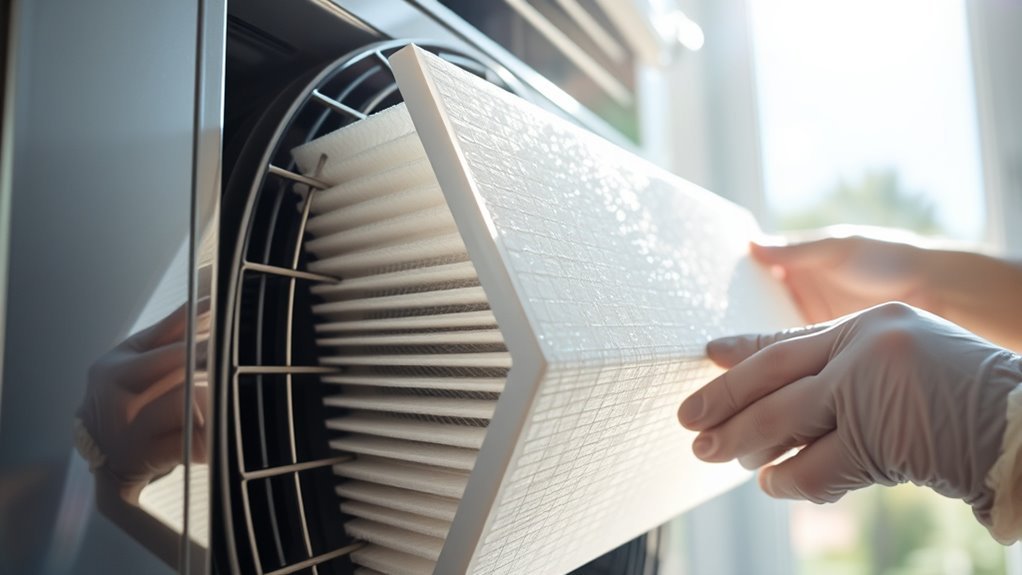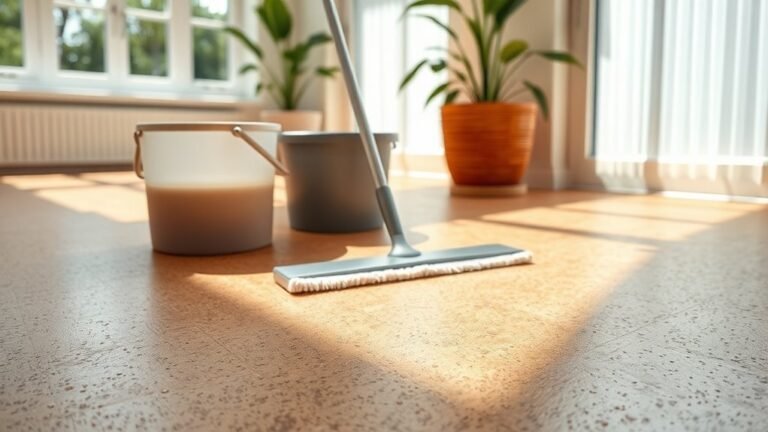How to Clean Your AC in 10 Minutes
To clean your AC in 10 minutes, first gather essential tools like a soft brush, vacuum with brush attachment, and mild detergent. Always turn off and unplug the unit for safety. Next, remove and either vacuum or replace the air filter to maintain airflow. Wipe down exterior surfaces and vacuum the vents to clear dust. Finally, check the drainage system for clogs and clear minor blockages. Following these steps guarantees efficient operation and longevity—explore detailed tips for thorough upkeep.
Gather Your Cleaning Supplies

Before you begin cleaning your AC, you’ll need to gather the necessary supplies to guarantee an effective and safe process. Essential cleaning tools include a soft brush, a vacuum cleaner with a brush attachment, a spray bottle filled with a mild detergent solution, and microfiber cloths for wiping. You’ll also want a fin comb to straighten bent fins on the condenser coils. These items make certain you can address dust, dirt, and debris without damaging delicate components. Following maintenance tips, such as using non-abrasive cleaners and avoiding excessive water exposure, preserves your unit’s integrity. Having these supplies ready not only streamlines the cleaning process but also gives you the freedom to maintain your AC efficiently, preventing costly repairs and enhancing system performance with minimal effort.
Turn Off and Unplug the AC Unit
With your cleaning supplies ready, the next step is to assure your safety by turning off and unplugging the AC unit. This fundamental safety precaution prevents electrical shock and protects the unit’s internal components during cleaning. First, locate the power source, whether a wall outlet or a dedicated circuit breaker. Switch off the unit using the power button, then disconnect the plug from the outlet. If your AC is hardwired, shut off the corresponding circuit breaker to assure complete disconnection from electricity. Confirm the unit is fully powered down before proceeding. Taking these steps assures you maintain control over your environment without risking injury or damage. Prioritizing these safety precautions allows you to clean your AC confidently and effectively without compromising your freedom or well-being.
Clean or Replace the Air Filter

One of the most critical maintenance tasks for your AC unit is cleaning or replacing the air filter regularly. Proper air filter maintenance guarantees peak airflow, improves energy efficiency, and prolongs your unit’s lifespan. Start by locating the filter compartment, usually behind a panel. Remove the filter carefully to avoid dispersing dust. If the filter is reusable, vacuum or rinse it with water and let it dry completely before reinserting. For disposable filters, promptly perform filter replacement using the correct size and rating specified by the manufacturer. Neglecting air filter maintenance can reduce cooling performance and increase energy consumption, limiting your freedom from high utility bills. By routinely addressing the air filter, you maintain clean air circulation and keep your AC running smoothly without hassle or delay.
Wipe Down the Exterior and Vents
After ensuring your air filter is clean or replaced, it’s important to attend to the exterior surfaces and vents of your AC unit. Begin exterior maintenance by turning off the power to prevent any electrical hazards. Use a damp cloth with mild detergent to wipe down the casing, removing dust, dirt, and debris that can impair performance. For vent cleaning, carefully vacuum the vents with a brush attachment to dislodge particles trapped inside. If necessary, use a soft brush or compressed air to reach deeper into vent slats. This step improves airflow efficiency and prevents contaminants from circulating. Regular exterior maintenance and vent cleaning not only extend your unit’s lifespan but also enhance cooling effectiveness, giving you the freedom to enjoy maximum indoor comfort without unexpected breakdowns.
Check and Clear the Drainage System

Before your AC can effectively remove moisture from the air, its drainage system must be clear and functional. Start by locating the drain pan beneath the evaporator coil; inspect it for standing water, which signals potential clogs. Next, check the drain line for blockages caused by dirt or algae. You can clear minor clogs by flushing the line with a mixture of water and vinegar using a funnel or a wet/dry vacuum. Regular drainage maintenance prevents water buildup that can lead to mold growth and system damage. Ensuring the drainage system operates smoothly safeguards your AC’s efficiency and your freedom from costly repairs. Make this a routine step in your cleaning process to maintain ideal airflow and moisture control throughout the cooling season.
Frequently Asked Questions
How Often Should I Deep Clean My AC Unit Annually?
Coincidentally, as the seasons shift, your AC’s efficiency depends on timely care. You should deep clean your AC unit at least once a year to guarantee peak performance. Seasonal maintenance is essential, especially before summer and winter, to prevent breakdowns. Don’t forget to replace filters every 1-3 months to maintain air quality and system health. Staying on top of this gives you freedom from unexpected repairs and keeps your environment comfortable year-round.
Can I Use Household Cleaners on AC Coils Safely?
You shouldn’t use typical household cleaners on AC coils because they can damage the delicate fins or leave residues that hinder coil cleaning effectiveness. Instead, opt for a cleaner specifically designed for coil cleaning, which safely removes dirt and grime without causing corrosion. Using the right product lets you maintain ideal airflow and efficiency, giving you freedom from costly repairs or reduced cooling performance down the line. Always follow manufacturer guidelines for best results.
What Are Signs My AC Needs Professional Servicing?
If your AC’s performance feels like a car struggling up a hill, it might need professional servicing. Pay attention to airflow issues, such as weak or inconsistent air delivery, and unusual noises like grinding or rattling sounds. These symptoms often indicate clogged filters, refrigerant leaks, or mechanical problems. Addressing these early guarantees your system runs efficiently, giving you the freedom to enjoy a comfortable, worry-free environment without unexpected breakdowns.
Is It Necessary to Clean the AC Remote Control?
Yes, remote maintenance is key for your AC’s ideal performance and hygiene importance can’t be overlooked. Dirt and bacteria accumulate on the remote control, potentially affecting both your health and device functionality. Regularly wiping the remote with a soft, slightly damp cloth prevents grime buildup and guarantees responsive buttons. This small maintenance step supports your freedom to control comfort effortlessly, keeping your environment clean and your device working smoothly.
How Do I Prevent Mold Growth Inside the AC?
To prevent mold growth inside your AC, you need regular mold prevention and AC maintenance. Always keep the filters clean and dry, as moisture fosters mold. Guarantee proper drainage by checking the condensate drain line for clogs. Run your AC on fan mode for a few minutes after cooling to dry internal components. Also, schedule professional maintenance annually to inspect and clean hard-to-reach areas, guaranteeing your system stays mold-free and efficient.






